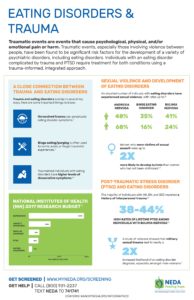 This week is National Eating Disorders Awareness Week. Eating disorders and related body image distortion disorders are difficult to cope with and treat. Eating disorders are serious mental health conditions in which a person’s relationship to food, to the intake or behaviors around food, or to the body is unhealthy. A negative relationship to food, food intake, or the body may develop in response to traumatic experiences in which a person felt or continues to feel little control over her or his life. There are several types of eating disorders, the most common of which are anorexia nervosa, bulimia nervosa, and binge eating disorder. More than 30 million people in the U.S. will suffer from an eating disorder and over 70 percent of those who cope with eating disorders will not seek treatment for various reasons. Eating disorders are challenging to deal with but can be treated. Treatment often involves psychological interventions, diet and nutritional counseling, and medical supervision.
This week is National Eating Disorders Awareness Week. Eating disorders and related body image distortion disorders are difficult to cope with and treat. Eating disorders are serious mental health conditions in which a person’s relationship to food, to the intake or behaviors around food, or to the body is unhealthy. A negative relationship to food, food intake, or the body may develop in response to traumatic experiences in which a person felt or continues to feel little control over her or his life. There are several types of eating disorders, the most common of which are anorexia nervosa, bulimia nervosa, and binge eating disorder. More than 30 million people in the U.S. will suffer from an eating disorder and over 70 percent of those who cope with eating disorders will not seek treatment for various reasons. Eating disorders are challenging to deal with but can be treated. Treatment often involves psychological interventions, diet and nutritional counseling, and medical supervision.
EMDR therapy is used as a psychological intervention to help clients with eating disorders. There is a robust body of work about the clinical use of EMDR therapy with eating disorders, and research is being conducted to support this work. Below are some resources that could be helpful for EMDR therapists working with this population. Feel free to contact info@emdria.org with additional resources for review. EMDRIA has an online community named EMDR and Eating Disorders for EMDRIA members to share questions and best practices about their clients dealing with eating disorders. For EMDR trained therapists, search for applicable upcoming workshops on our Education Calendar.
EMDR Protocol Adaptations for Eating Disorders and Body Dysmorphia
Beer, R. (2019). Protocol for EMDR therapy in the treatment of eating disorders. In M. Luber, (Ed.), Eye movement desensitization and reprocessing (EMDR) therapy scripted protocols and summary sheets: Treating eating disorders, chronic pain, and maladaptive self-care behaviors (pp. 11-64). New York, NY: Springer Publishing Co.
Forester, D. (2009). Image is everything: The EMDR protocol in the treatment of body dysmorphia and poor body image. In R. Shapiro (Ed.), EMDR solutions II (pp. 165-174). New York, NY: W. W. Norton and Co.
Forester, D. (2019). Eye movement desensitization and reprocessing (EMDR). In A. Seubert and P. Virdi (Eds.), Trauma-informed approaches to eating disorders (pp. 165-178). New York, NY: Springer Publishing Co.
Seijo, N. (2019). EMDR therapy protocol for eating disorders. In M. Luber, (Ed.), Eye movement desensitization and reprocessing (EMDR) therapy scripted protocols and summary sheets: Treating eating disorders, chronic pain, and maladaptive self-care behaviors (pp. 143-194). New York, NY: Springer Publishing Co.
Seijo, N. (2019). The rejected self EMDR therapy protocol for body image distortion. In M. Luber, (Ed.), Eye movement desensitization and reprocessing (EMDR) therapy scripted protocols and summary sheets: Treating eating disorders, chronic pain, and maladaptive self-care behaviors (pp. 217-238). New York, NY: Springer Publishing Co.
Zaccagnino, M. (2019). EMDR therapy protocol for the management of dysfunctional eating behaviors in anorexia nervosa. In M. Luber, (Ed.), Eye movement desensitization and reprocessing (EMDR) therapy scripted protocols and summary sheets: Treating eating disorders, chronic pain, and maladaptive self-care behaviors (pp. 79-126). New York, NY: Springer Publishing Co.
Peer-Reviewed Research Articles (Note that not all are open access, but those that are should be indicated that way.)
Balbo, M., Zaccagnino, M., Cussino, M., & Civilotti, C. (2017). Eye movement desensitization and reprocessing (EMDR) and eating disorders: A systematic review. Clinical Neuropsychiatry, 14(5), 321-329. Open access: https://www.clinicalneuropsychiatry.org/clinical-neuropsychiatry-volume-14-issue-5-october-2017/
Bloomgarden, A., & Calogero, R. M. (2008). A randomized experimental test of the efficacy of EMDR treatment on negative body image in eating disorder inpatients. Eating Disorders: The Journal of Treatment & Prevention, 16(5), 418-427. https://doi.org/10.1080/10640260802370598
Brewerton, T. D. (2018). An overview of trauma-informed care and practice for eating disorders. Journal of Aggression, Maltreatment & Trauma, 1-18. https://doi.org/10.1080/10926771.2018.1532940
Brown, K. W., McGoldrick, T., & Buchanan, R. (1997). Body dysmorphic disorder: Seven cases treated with eye movement desensitization and reprocessing. Behavioural and Cognitive Psychotherapy, 25(2), 203-207. https://doi.org/10.1017/S1352465800018403
Cardazzone, E., Gallucci, M., Callerame, C., Cussino, M., Gelo, O., Pasca, P., & Zaccagnino, M. (2021). Linguistic changes during EMDR sessions: A preliminary single-case study. Counselling & Psychotherapy Research, 12394. https://doi.org/10.1002/capr.12394
Dziegielewski, S., & Wolfe, P. (2000). Eye movement desensitization and reprocessing (EMDR) as a time-limited treatment intervention for body image disturbance and self-esteem: A single-subject case study design. Journal of Psychotherapy in Independent Practice, 1(3), 1-16. https://doi.org/10.1300/J288v01n03_01
Halvgaard, K. (2015). Single case study: Does EMDR psychotherapy work on emotional eating? Journal of EMDR Practice and Research, 9(4), 188-197. Open access: http://dx.doi.org/10.1891/1933-3196.9.4.188
Janssen, H. (2012). A special case (series): EMDR treatment of early childhood trauma in a client with an eating disorder. Tijdschrift voor Psychotherapie, 38(1), 21-37. [Dutch] https://doi.org/10.1007/s12485-012-0003-3
Kazen, M., Baumann, N., Twenhofel, J. F., & Kuhl, J. (2019). When do anorexic patients perceive their bodies as too fat? Aggravating and ameliorating factors. PLOS ONE, 14(2), e0212612. Open access: https://doi.org/10.1371/journal.pone.0212612
Seijo, N. (2012). EMDR and eating disorders. Revista Iberoamericana de Psicotraumatologia y Disociacion, 4(2). [Spanish] Open access: https://www.revibapst.com/volumen-4-numero-2-2012
Seubert, A. (2018). Becoming known: A relational model utilizing Gestalt and ego state-assisted EMDR in treating eating disorders. Journal of EMDR Practice and Research, 12(2), 71-86. Open access: http://dx.doi.org/10.1891/1933-3196.12.2.71
Yasar, A. B., Abamor, A. E., Usta, F. D., Taycan, S. E., & Kaya, B. (2019). Two cases with avoidant/restrictive food intake disorder (ARFID): Effectiveness of EMDR and CBT combination on eating disorders (ED). Turkish Journal of Clinical Psychiatry [Klinik Psikiyatri Dergisi], 22(4), 493-500. DOI: 10.5505/kpd.2019.04127 Open access: http://www.klinikpsikiyatri.org/jvi.aspx?pdir=kpd&plng=tur&un=KPD-04127
Yasar, A. B., Usta, F. D., Abamor, A. E., Taycan, S. E., & Kaya, B. (2017). EMDR therapy on trauma-based restrictive eating cases. European Psychiatry, 41, S560-S561. https://doi.org/10.1016/j.eurpsy.2017.01.811
Zaccagnino, M., Cussino, M., Callerame, C., Civilotti, C., & Fernandez, I. (2017). Anorexia nervosa and EMDR: A clinical case. Journal of EMDR Practice and Research, 11(1), 43-53. Open access: http://dx.doi.org/10.1891/1933-3196.11.1.43
Other Books/Chapters
Cooke, L. & Grand, C. (2009). The neurobiology of eating disorders, affect regulations skills, and EMDR in the treatment of eating disorders. In R. Shapiro (Ed.), EMDR solutions II: For depression, eating disorders, performance, and more (pp. 129-150). New York: W.W. Norton & Company, Inc.
Forester, D. (2009). Treating bulimia nervosa with EMDR. In R. Shapiro (Ed.), EMDR solutions II: For depression, eating disorders, performance, and more (pp. 151-164). New York: W.W. Norton & Company, Inc.
Gross, L., & Ratner, H. (2002). The use of hypnosis and EMDR combined with energy therapies in the treatment of phobias and dissociative, posttraumatic stress, and eating disorders. In F. P. Gallo (Ed.), Energy psychology in psychotherapy: A comprehensive sourcebook (1st ed., pp. 219-231). New York, NY: W. W. Norton
Lidov, C. (2009). Desensitizing desire: Nonverbal memory and body sensations in the EMDR treatment of eating disorders. In R. Shapiro (Ed.), EMDR solutions II: For depression, eating disorders, performance, and more (pp. 183-192). New York: W.W. Norton & Company, Inc.
McGee, J. (2009). Addressing retraumatization and relapse when using EMDR with eating disorder patients. In R. Shapiro (Ed.), EMDR solutions II: For depression, eating disorders, performance, and more (pp. 175-182). New York: W.W. Norton & Company, Inc.
Scholom, J. (2009). Integrating eating disorders treatment into the early phases of the EMDR protocol. In R. Shapiro (Ed.), EMDR solutions II: For depression, eating disorders, performance, and more (pp. 114-128). New York: W.W. Norton & Company, Inc.
Schulherr, S. (2005). Exiting the binge-diet cycle. In R. Shapiro (Ed.), EMDR solutions: Pathways to healing (pp. 241-262). New York, NY: W. W. Norton & Company, Inc.
Seubert, A. (2009). The why of eating disorders. In R. Shapiro (Ed.), EMDR solutions II: For depression, eating disorders, performance, and more. (pp. 109-113). New York: W.W. Norton & Company, Inc.
Seubert, A. & Lightstone, J. (2009). The case of mistaken identity: Ego states and eating disorders. In R. Shapiro (Ed.), EMDR solutions II: For depression, eating disorders, performance, and more (pp. 193-217). New York: W.W. Norton & Company, Inc.
Seubert, A. & Virdi, P. (Eds.). (2019). Trauma-informed approaches to eating disorders. New York: Springer Publishing Company.
Zaccagnino, M., Cussino, M., Callerame, C., Civilotti, C., & Fernandez, I. (2017). EMDR in anorexia nervosa: From a theoretical framework to the treatment guidelines. In I. Jauregui-Lobera (Ed.), Eating disorders – A paradigm of the biopsychosocial model of illness (pp. 195-213). Rijeka, Croatia: InTech. DOI: 10.5772/65695 Open access: https://www.intechopen.com/books/eating-disorders-a-paradigm-of-the-biopsychosocial-model-of-illness/emdr-in-anorexia-nervosa-from-a-theoretical-framework-to-the-treatment-guidelines
Other Articles
Boghosian, J. (2020, Oct 29). Complex-PTSD, eating disorders, and the role EMDR plays. Eating Disorder Hope. https://www.eatingdisorderhope.com/blog/complex-ptsd-eating-disorders-and-the-role-emdr-plays
Cameron, V. L. (2013). EMDR: Promising treatment for co-occurring eating disorders and childhood sexual abuse [Masters thesis, St. Catherine University]. Retrieved from https://sophia.stkate.edu/msw_papers/160/
Back to Focal Point Blog Homepage
Additional Resources
If you are a therapist interested in the EMDR training:
- Learn more about EMDR at the EMDRIA Library
- Learn more about EMDR Training
- Search for an EMDR Training Provider
- Check out our EMDR Training FAQ
If you are EMDR trained:
- Check out EMDRIA’s Let’s Talk EMDR Podcast
- Check out the EMDRIA Focal Point Blog
- Learn more about EMDRIA membership
- Search for Continuing Education opportunities
If you are an EMDRIA Member:
Date
February 22, 2021
Topics
Eating Disorders/Body Image





